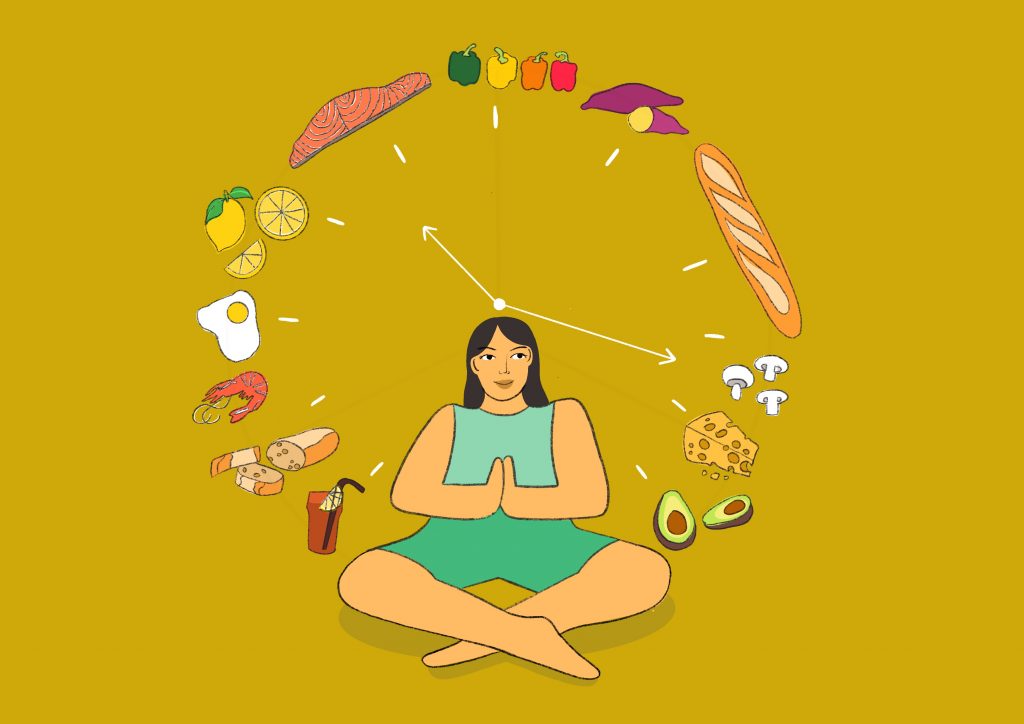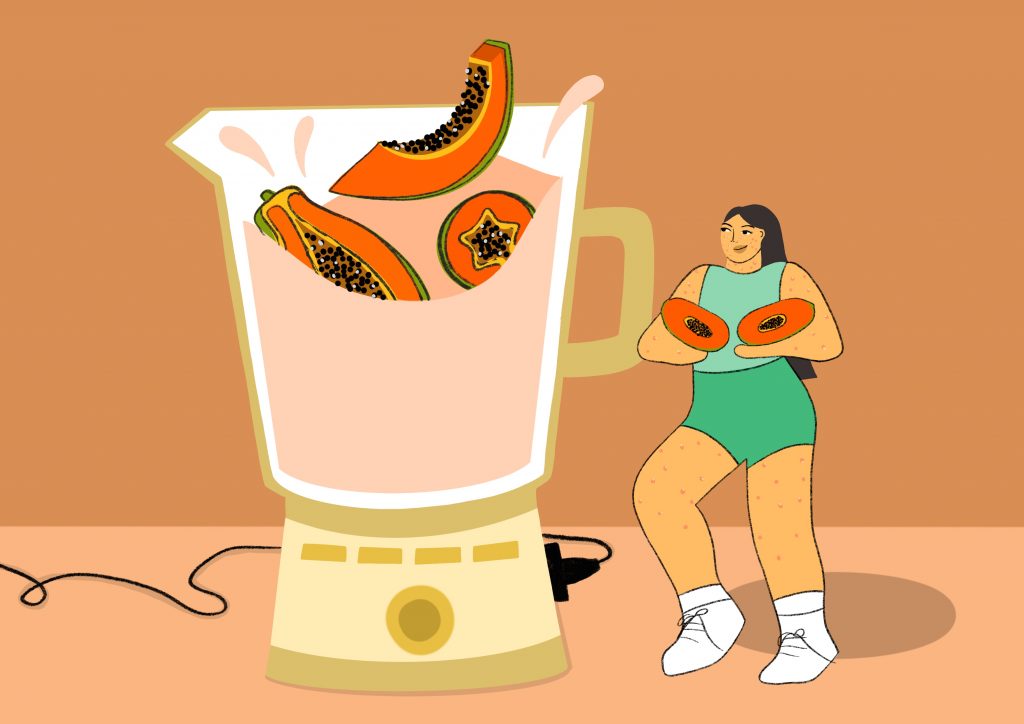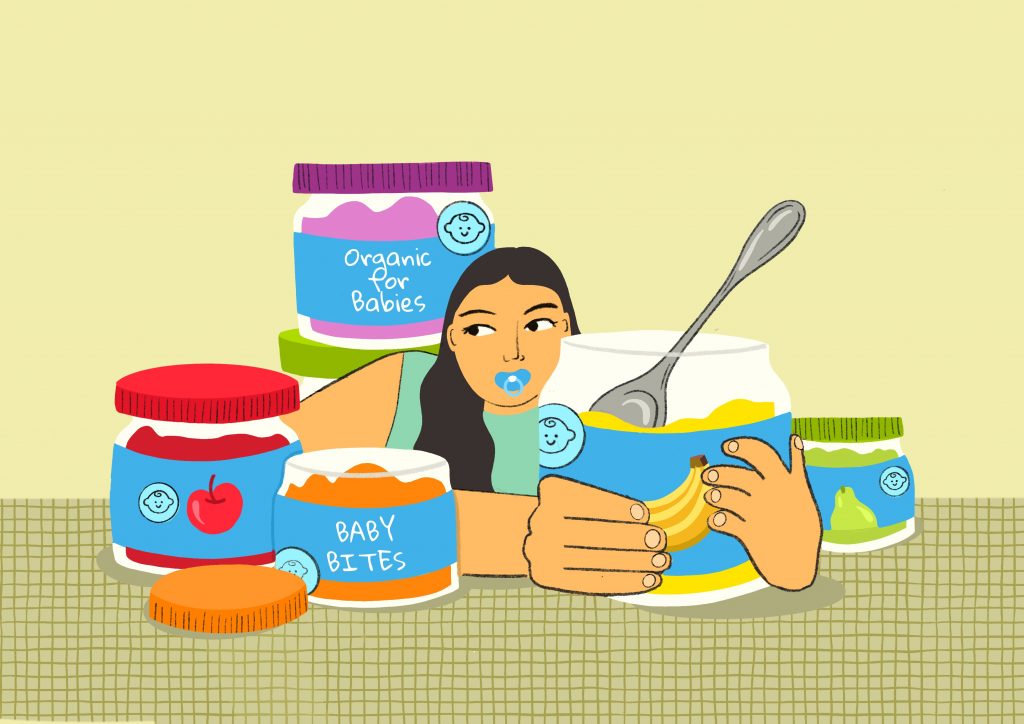All illustrations by Syada Yunos for RICE Media.
A memory from a family gathering 15 years ago remains in my mind.
Long story short: A relative was proudly showing off a brand-new vibrating belt. For just $35, the product promised rock-solid abs. No exercise needed.
This is known as a health fad.
Last I heard, it’s now another long-abandoned piece of equipment.
Ridiculous health fads like those aren’t new to us, yet there’s always something in vogue. Recall, if you will, the height of Covid. Parents heard that coconut water worked wonders against the virus. Sales spiked as people hoarded the drink.
Since the boom, the claim’s been debunked. Let’s ignore the ivermectin fiasco.
A health fad is a fad when it promises one thing: dramatic results. Once they’re popularised through viral videos or word-of-mouth, some of us buy in.
Misguided or not, they’re all done in the name of health—something many of us struggle to manage or even understand.
1. The Going with the Gut Gal

The Attempt:
Like many, I’ve subscribed to a couple of health fads myself. I’m guilty of self-diagnosing too.
Heartburn, bloating, burping? You name it. First, it was Irritable Bowel Syndrome (IBS), then Gastroesophageal Reflux (GERD), or Acid Reflux.
I’m all for good food, even if it comes with a dose of pain. Post-meal, I walk out of a restaurant with the grace of a “lanky pregnant lizard”, as my friends would say.
The sensation’s hard to describe—it’s both acidic and bitter; a distinct burning sensation in the chest that makes digestion feel like it welcomes a wave of bile.
Almost as convenient as my “diagnosis” were the self-prescribed solutions. Online, I stumbled upon the idea of Intuitive Eating. The whole point is to eat only when you’re hungry and stop when you’re full. All you gotta do is listen to your body and make food choices that feel good.
It sounded simple and harmless enough—except I began feeling more sluggish than ever. In reality, I ate too much or too little, and only at the oddest hours. Mealtimes were shockingly inconsistent. Hunger came at 4PM or 12AM. At times, it didn’t come at all.
That meant I could do with one huge meal or six small ones a day. A bowl of plain oats or Samyang Spicy Noodles topped with veggies, fried egg and pork belly slices.
Needless to say; it failed. And I still feel like a bloated lizard most days.
The Professional Take:
According to Pooja Vig, the 52-year-old Clinic Director and Functional Medicine Nutritionist of The Nutrition Clinic, there shouldn’t be any shortcuts to good health at all.
She tells me that several factors may be causing such bloating symptoms. It’s actually pretty common. Data and knowledge are key here. Not viral trends but actual facts that will lead to wise, healthy decisions for ourselves.
“Everyone is really different,” Pooja notes. “It could be the status of your gut microbiome, or you may even have food sensitivities that have yet to be discovered. These need to be thoroughly investigated.”
Whichever the case, she recommends starting with a basic health test before going on yet another wild Google chase. For starters, that’ll help paint a better understanding of the body’s overall condition—what it lacks and what appropriate tweaks should be made to the diet.
2. The Papaya Shake & Collagen Stan

The Attempt:
If you’re part of the itty-bitty-titty club, you might have heard of the Papaya Milkshake Theory. Apparently, the drink’s said to be a natural remedy for breast enlargement.
Its winning ingredient, phytoestrogens, is a plant-based compound that produces estrogen-like effects. It’s said to aid in reproductive development, particularly for women.
23-year-old Fion first learned about it through a Taiwanese Variety programme back in Secondary School. “I don’t recall who exactly, but celebrities were raving about this on a variety show,” she recounts, “I was instantly sold on the idea. My mom even spurred me on.”
During puberty, Fion would buy papayas and religiously prepare them every day. On days when time isn’t of the essence, she’ll actively seek out fruit juice stalls that sell them too. “It was a self-image thing, and I guess I was caught up with comparing myself with others.”
She’s embarrassed looking back at the episode now.
“Who even decided that big breasts were best??”
Then came acne and the height of K-pop. As much as she began obsessing over Korean culture, she became equally invested in achieving good skin. Whatever little she saved from pocket money quickly went into beauty products.
Not to mention collagen hot pots too. To this day, she hears a particular nagging in her head: “Drink more soup! It’s good for your complexion!” It’s one she grew up hearing repeatedly like a broken record.
“All these celebrities have such crystal glowy skin and silky hair. I felt horrible about myself with my acne-prone skin,” she recalls. Desperate in her hope that collagen hotpots are the long-fabled Fountain of Youth, Fion made it a point to consume them at least once a month.
The Professional Take:
Having been in the health industry for 15 years, Pooja’s unfazed by the ridiculousness of these fads. This includes the belief that people need less protein as they age (Fun fact: It’s false). That said, she’s never heard of the Papaya Milkshake fad and refrained from chiming in on its efficacy.
As a rule of thumb, she’s wary of anything touted as a cure-all miracle.
Asked about her thoughts on lesser-known alternatives like edible Bird’s Nests, she isn’t quick to dismiss them. Like hot pots, Bird’s Nests provide a rich source of collagen, too and are proven to be effective in improving skin health.
Among many other healthy food choices, Pooja affirms that traditional remedies definitely have their place in the system. There’s no harm in trying a new thing, it seems. “Food like Bird’s Nests can be used as part one’s wider toolkit,” she adds.
“Just not a miracle that will override the effects of other factors like poor sleep and stress.”
3. The Avid Trend Hopper

The Attempt:
Much like a seasoned cafe hopper, 28-year-old *Norah is more than familiar with health fads too. She’s jumped from one to another all her life. She points to Tumblr, YouTube and online forums as her main source of information.
“I’d get on whatever that’s trending, basically.”
She goes on to tell me all about the Baby Food Diet and Apple Diet—both of which she had tried on separate occasions.
“Being my lazy self, I bought pre-made baby food. The ones in jars from the supermarket—I had them for meals. Oh my god, they tasted so bad.”
I’m not surprised. Replacing breakfast and lunch with jars of pureed ham and strained peas? That doesn’t sound appetising at all.
It took diligence on her part to ensure that things were going to plan. As much as possible, she’d avoid dining out. Otherwise, she’d strategically schedule social activities before or after meals. Like Fion, this was driven by her obsession with attaining society-defined “good looks”.
“Thinness was a trend. For whatever reason, so many people wanted to get rid of a thigh gap. I did too.” These attempts were rarely about health, which she now realises at an older age.
“I’ve learned that there’s a limit to how much you can sleep hunger away. The more you can’t have something, the more your body naturally craves it.”
Before she saw any results, she was on to the next thing.
As her myopia began to deteriorate, she began consuming more carrots. She even volunteered to have friends’ leftovers whenever carrots were the ones left uneaten. Her vision continues to worsen at -600 degrees today, so all that conscious consumption proved futile.
The apple diet? It required her to eat at least three a day—one enough to keep the doctor away, three to cause alarm.
The Professional Take:
“These kinds of health fads—the ‘Baby Food and Apples Diet’—contain misinformation which can be very dangerous,” Pooja laments, stressing that they can cause “extreme nutritional deficiencies.”
According to her, weight management is more about the quality of food. It’s bad practice to simply count calories. She recommends looking at macronutrients and the glycemic load (how quickly food affects your blood sugar) instead.
It’s not that clear-cut. “There’s also other factors—the consideration of hormones, for instance, and how that can impact someone’s weight and metabolism.”
Norah isn’t entirely wrong about carrots though. Pooja chimes in: “Orange foods like carrots, mangos and apricots are high in beta-carotene, which is a form of Vitamin A. It’s what you need for good eyesight. Still, she stresses the dangers. Say, if someone has high blood sugar or insulin resistance, it might not be good to have them all the time.
“Again, this loops back to bio-individuality.”
Just because it works for one person, doesn’t mean it’s a one-size-fits-all.
Too Good to Be True
Behold the ever-growing list of health & wellness myths. Some of these have been so ingrained in us, even if they’re baseless and lack clear scientific research. It’s not surprising, considering we live in a world where celebrity diets are somehow praised and glorified.
It’s hard to sift through what’s best for us when there are infinite routes to good health. Whatever the case, take it from a professional. Register for a health screening; rely on trusted sources instead.
Safe to say, you won’t find good health after inhaling packs of chia seeds. The key isn’t hiding in a fad diet or elimination regime. If it sounds too good to be true, it probably is.
*Name has been changed for anonymity






